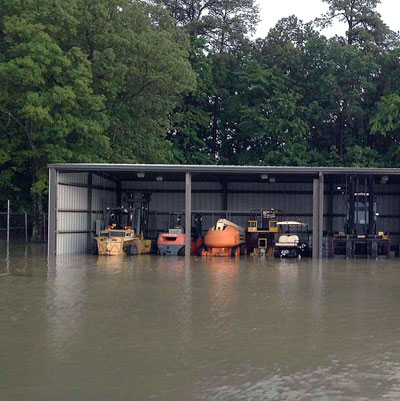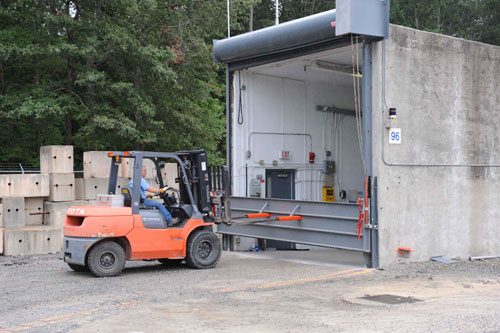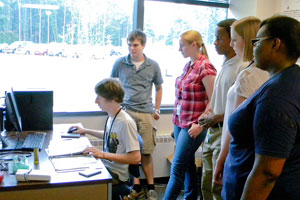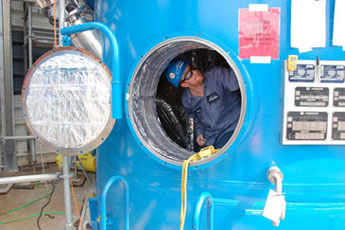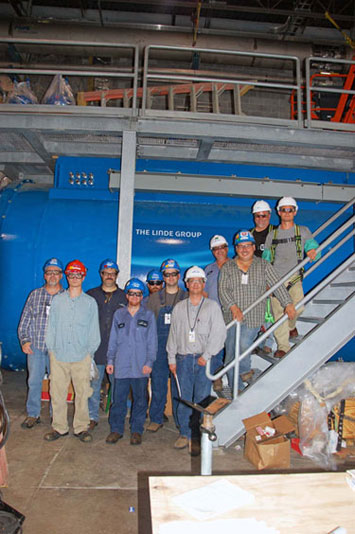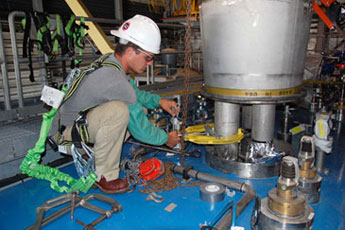
|
September 2012
|
|
|
The U.S. Department of Energy's Thomas Jefferson National Accelerator Facility
|
|
The Butterfly in the Machine |
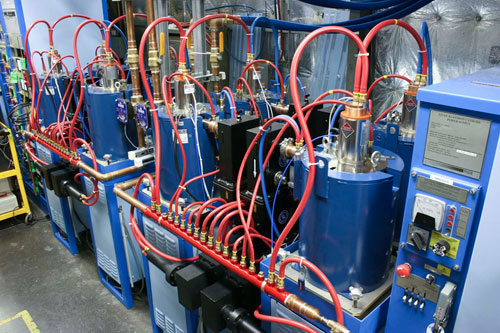
Eight blue radiofrequency amplifiers, called klystrons, boost the low-level RF system baseline signals before they are funneled into the cavities in the 12 GeV Upgrade cryomodules. Photo by Andrew Kimber.
Small changes can have great effects. A mathematical model built in the 1960s to study weather patterns proved this when it found that tiny changes in weather conditions led to wildly different weather scenarios weeks later, analogous to the gentle flutters of a single butterfly's wings eventually sparking a hurricane. Edward Norton Lorenz, the MIT meteorologist who built the model, later coined the term "butterfly effect" to describe this phenomenon. Now, this principle is being applied in Jefferson Lab's Continuous Electron Beam Accelerator Facility. There, those who build and operate the lab's accelerator are using minute tweaks to a low-powered system to exert fine control over the enormous energies that power the accelerator...... more |
|
|
Heavy August Rains Cause Flooding at Jefferson Lab
|
Hall Leader's Love of Science Grew from Tinkering in Father's Shop
|
Engineer Drawn to Lab's Magnet Group
|
||
|
|
||||
Below the Fold: |
||||
The Butterfly in the Machine |
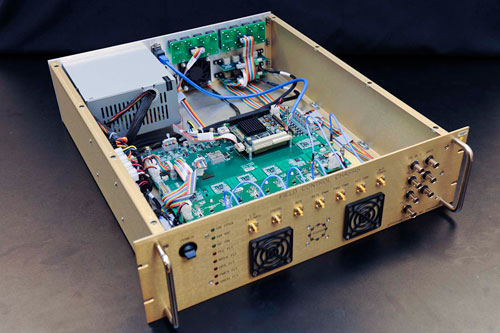
The low-level radiofrequency system control chassis provides the feedback and the processing to stabilize an accelerator cavity through the low-level RF signal.
Small changes can have great effects. A mathematical model built in the 1960s to study weather patterns proved this when it found that tiny changes in weather conditions led to wildly different weather scenarios weeks later, analogous to the gentle flutters of a single butterfly's wings eventually sparking a hurricane. Edward Norton Lorenz, the MIT meteorologist who built the model, later coined the term "butterfly effect" to describe this phenomenon. Now, this principle is being applied in Jefferson Lab's Continuous Electron Beam Accelerator Facility. There, those who build and operate the lab's accelerator are using minute tweaks to a low-powered system to exert fine control over the enormous energies that power the accelerator. The system, known as the low-level radiofrequency, or low-level RF system, was designed for use with new components that are being installed in CEBAF for the 12 GeV Upgrade. The upgrade is a $310 million project that will enhance the research capabilities of CEBAF by doubling its energy to 12 billion electron volts, or GeV, along with other upgrades and additions. The upgraded CEBAF will provide scientists with unprecedented precision and reach for studies of the particles and forces that build our visible universe. To double the energy of the accelerator, 10 new modular sections called cryomodules are being added to the accelerator. These cryomodules house metal cavities that harness energy that is pumped into them, focusing it onto, and thus accelerating, a thin beam of electrons. The cavities are powered by radiofrequency, or RF, energy. Jefferson Lab's Electrical Engineering - Radiofrequency Project group designed, manufactured and installed the new, low-level RF system for the new cryomodules. The high-power section of the RF system was also designed, built, and installed by members of the Electrical Engineering department. This high-power system amplifies the low-level RF signal and applies it to the cavities. "Work on the cryomodules started about 10 years ago. And we started about five years ago to re-do the RF system for these cryomodules," said Curt Hovater, who leads the RF Project group. Tomasz Plawski, an engineer in the group, explained that the low-level RF system features a specially built circuit board that runs a sophisticated control algorithm, all designed by Jefferson Lab staffers. The system provides the baseline signal that is sent into the accelerator cavities. RF amplifiers, called klystrons, boost baseline signals before they are funneled into the cavities. "Our low-level RF system is low-level, because we are operating on very little power, like milliwatts," Plawski said. "We send this milliwatt signal out, and it is amplified to the kilowatts level." The low-level RF system not only forms the basis for the RF energy that is delivered into the cavities, it also allows for fine control of that energy. The cavities focus the energy into a field that accelerates electrons, and this accelerating field must remain stable and constant as electrons zoom through CEBAF’s string of 400 cavities – 320 original cavities and 80 upgrade cavities. Following the upgrade, the new low-level RF system will constantly measure the field in the 80 upgrade cavities and modify the signal for each one to ensure that the cavities operate optimally. "There are a lot of things that will disturb the cavity. One of them is microphonics, which is when the cavity tends to shake. There is also beam load, when you increase the amount of electrons going into the cavities, and they steal the energy from the cavity," Plawski said. "So, we measure the field in the cavity and we compensate for any variation in this field. The stabilization of the accelerating field is the main task of the low-level RF system." Lab's Early LLRF Effort Included Work for Cornell
The desire to develop a digital low-level radiofrequency, or LLRF, system goes back more than a decade in the international accelerator community. During the first-ever LLRF workshop, held at Jefferson Lab in 2001, the LLRF community concluded that a digital self-excited loop (SEL) approach would be best for continuous-wave machines like CEBAF. In parallel, Cornell University and Jefferson Lab began developing separate LLRF systems, and in a Cornell/JLab collaboration, Cornell tested its hardware at JLab. The Digital Divide "We had to translate everything from the analog world – get it digitized – and then figure out what algorithms to use from there," said Trent Allison, a Jefferson Lab electrical engineer who has contributed to the project. In the old system, signal processing using RF-analog electronics made the machine susceptible to temperature drifts. The machine also tended to go out of calibration over time, requiring maintenance and constant adjustments, which are eliminated in the new system. As Jefferson Lab staffers designed the new digital system for the 12 GeV Upgrade from the ground up, they developed many new pieces of equipment. Among the new components are a patented digital self-excited loop and an off-the-shelf Field Programmable Gate Array (FPGA) processor that was customized by the group. "The main piece is the FPGA or control board, which takes in the signals, does all the digital processing, and then sends out the drive signals to drive the cavities. The FPGA is the thing that is actually controlling the cavity and making all of the decisions as to what goes on," Allison noted. "There are other peripherals, like stepper motors and things that keep the cavity on resonance and interlocks to make sure everything's safe. Then things keep building out from there." Before being installed, the system was tested in a simulated environment. "One thing you can't do is just grab a cryomodule and go in any time and test it. We had to make an emulator, so that we could kind of gauge if our system would do anything at all," Allison said. From the earliest design and testing phases, the team also wanted to ensure that the new low-level RF components would seamlessly integrate with the software used to control the accelerator. George Lahti, a computer scientist in the Accelerator Operations Software Controls group, led that effort. "I would sit with them while they were developing the hardware in the design stage," Lahti said. "We did it on a test stand, working together with the hardware guys." 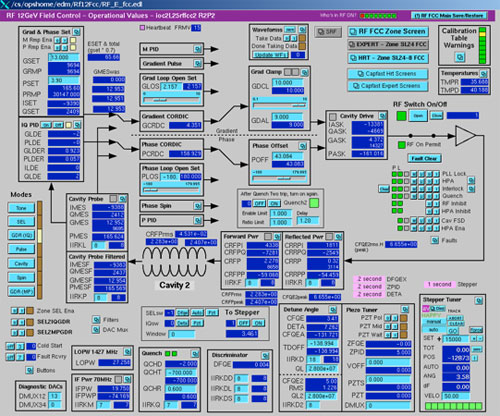
Low-level RF system designers and accelerator operators can run the system through control screens that work in EPICS, software that is used to run accelerators around the world.
Lahti is an expert in the Experimental Physics and Industrial Control System, or EPICS, software that is used to run accelerators around the world. He designed the interface of the new components of the system with EPICS. "An accelerator operator pushes a button, then the system turns that into a sequence of operations or a single operation," Lahti explained. "Both the system developers and operators use this level of software. The operators will look at certain parameters, and the system developers will go deeper into it." After the first of the new cryomodules were installed in CEBAF last year, the tests became real. The new, low-level RF system, with some tweaking to optimize its function, is one of the many upgrades that helped a 12 GeV cryomodule successfully meet its full design specification in the early-morning test run that was conducted on May 18. Those involved in the project attribute the successful functioning of the digital low-level RF system to the hard work and dedication of the core group who worked on the system, including Hovater, Allison, Plawski, Lahti, John Musson, Rama Bachimanchi, Dave Seidman, Mike Wilson and Hai Dong, as well as the many colleagues who assisted with the project. Beyond CEBAF Plawski has led the effort to reach out to other accelerator and research centers to provide them with similar systems of their own. So far, the team has built and/or is designing similar systems for the Jefferson Lab FEL, the Pohang Light Source in South Korea, for the University of Wisconsin Synchrotron Radiation Center and for the MIT inverse Compton scattering X-ray source. "As long as we have just cavities and charged particles, our low-level RF system can work with that," Plaswki said. "The main differences are the frequencies. Different machines are working at different frequencies. We have also to process this data at different speeds." He said those differences do require modifications of the system, and some of those modifications can be quite extensive. "It's not just we take our system and operate there. We spend a certain amount of time and effort to redesign this system. The core processor is the same. But the board has to be changed, because there are different frequencies and also different signals," Plawski explained. "There is some hardware modification, but the hardware is kind of modular. There is also a certain amount of labor necessary to accommodate this system to different machines." The Next Test "A lot of time was spent trying to get to one button that would turn the whole thing on for us without tripping off," Allison said. "It took a lot of test time, a lot of programming, and a lot of long nights." With the successful test run in May now behind them, Hovater and his colleagues are busy installing the digital low-level RF system for all of the new cryomodules that will be installed in the CEBAF accelerator over the Long Shutdown. The final test of the system is set for fall 2013, when it will power the new cryomodules in the newly upgraded accelerator as it comes online for the first time. By Kandice Carter |
Hall Leader's Love of Science Grew from
|
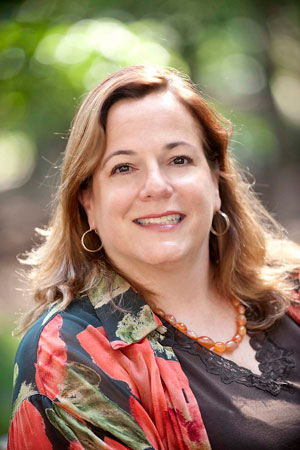
Cynthia Keppel
Group Leader Experimental Hall A As a child growing up in northern Virginia, Cynthia Keppel loved to tinker. Her dad, an entrepreneur with wide-ranging interests, was into race cars when she was young. "I used to sit in his shop and put things together, take them apart, and put them together again," she recalled. "I guess I was a budding experimentalist even then. I loved all the machines and grease and stuff." Her path to physics, though, was not a straightforward one. For her undergraduate work, she chose St. John's College in Annapolis, Md., the "great books" school that eschews traditional subject departments, classes, majors, textbooks and grades for a broad-based four-year education of reading, studying and discussing the most important books of the Western tradition. Everyone follows the same program, starting with the books of ancient Greece and continuing chronologically to modern times. A summer job at the Naval Research Laboratory for Computational Physics between her sophomore and junior years kick-started what would become her career. She was part of the newly emerging science of displaying digital scientific images, and converting multiple images into small films, done easily today, but what she calls "a big thing" then. She worked primarily with scientists involved in plasma physics, using and creating images for them in their work on predicting magnetic pole shifts. "This was very fun," she recalled, smiling at the memory of the excitement. "I really liked the science and I especially liked the culture of physics." So much so that she briefly considered leaving St. John's for a more traditional science education. "I realized that I really valued St. John's approach to learning, and decided to stick it out," she noted. She continued to work at NRL during school breaks and the following summer, and knew that she would pursue a graduate degree in physics. Trouble was, she had never taken a traditional physics class. "The nice thing about being young and naïve is that you think you can do anything," she said. "I figured I could learn it by reading about it." So she plunged into John David Jackson's Classical Electrodynamics and Halliday, Resnick and Walker's Fundamentals of Physics at the same time. She talked with the physicists she'd worked with for a better understanding of the material and did at least well enough on the GRE to be accepted to graduate school. Never one to shy away from excitement, Keppel started grad school, her husband, Barry, who she'd met at St. John's, started med school and she gave birth to their first child ... all in the same week. She'd heard Raymond Arnold talk in Washington about his work in electron scattering and knew she wanted to be part of that. As a result, she attended three semesters of classes at American University, then moved to northern California where Arnold's group was working in End Station A at SLAC. Barry, on his way to becoming a surgical pathologist, enrolled at George Washington University and then moved to a residency at Stanford. "This was a very exciting time to be at SLAC," Keppel noted, "and it was a wonderful training ground for me." As she was about to receive her Ph.D., it was a fortuitous time to return east: Hampton University was gearing up to embark on its inaugural Ph.D. physics program and Jefferson Lab was about to deliver its first beam to Hall C, an event that Keppel was here for. Since 1995, she has held a joint position as a professor at HU and a staff scientist at the lab. 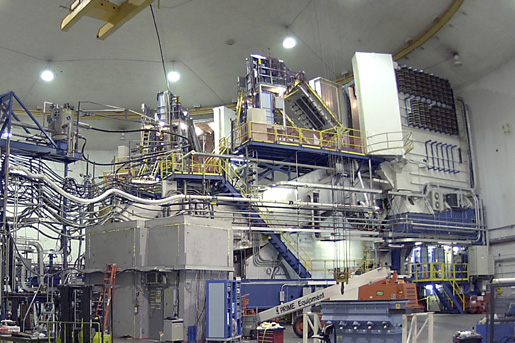
Hall A is slated to be the first hall to receive beam after the 12 GeV Upgrade project is completed.
During her time at HU, she founded the Center for Advanced Medical Instrumentation (CAMI), where her work resulted in numerous patents, both awarded and pending. These are focused on cancer diagnosis and treatment. She also established and co-directed the joint medical physics program with the Eastern Virginia Medical School and served as the scientific and technical director of Hampton University's Proton Therapy Institute. "Dr. (William) Harvey was a visionary in getting funding, and he gave me the technical reins," Keppel said. "We started the project around 2004, broke ground in 2007 and treated our first patients in 2010." The following year Keppel was honored with the Virginia Outstanding Scientist Award. During her time at Jefferson Lab, she has been the spokesperson or co-spokesperson for eight experiments and co-authored 170 peer-reviewed publications. She is also an active member of the Coordinated Theoretical-Experimental Project on Quantum Chromodynamics (CTEQ). Earlier this year Keppel was tapped to become the Hall A Group leader, a position that piques her life-long drive for excitement and science – the thrill of what she calls the "Aha! experience." "Hall A is truly the frontier here, since it will get the first beam after the upgrade is complete," she noted. "There are many experiments proposed, and still being proposed. It's a community full of fresh ideas, and there's opportunity to put something completely new, or a few things completely new, on the floor – no pre-set prescription. It's very exciting to be part of this." Keppel and her husband, who practices primarily at Mary Immaculate Hospital, live in the Lakewood section of Norfolk. Their son, Barry III, graduated from Lynchburg College two years ago and now lives in Gaithersburg, Md., where he works at an IT company. Their middle son Joel is a sophomore at William and Mary, and their daughter Abigail, who's 11, loves horseback riding and volleyball and attends Norfolk Collegiate school. The family enjoys water sports and traveling. She also does mission work with local youth and through the Orphan Network, and works with a national group that helps repair homes for people who cannot afford to do so. Keppel never lost the love of fast cars that grew from tinkering in her dad's shop. In fact, in the year between her graduation from St. John's and starting graduate school, she climbed into the driver's seat a bit herself and raced with the Sports Car Club of America (SCCA). And her BMW 335i makes that daily commute a joy, even in the summer when the tourists are clogging the roads. By Judi Tull |
Engineer Drawn to Lab's Magnet Group |
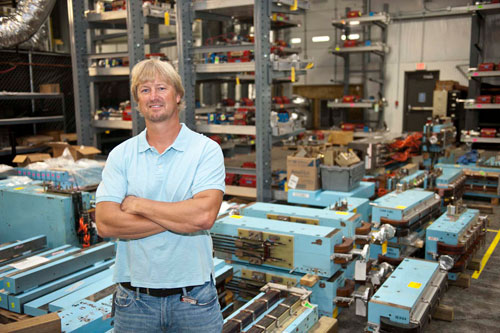
Ken Baggett, Magnet Measurement Facility group leader, stands among a small number of the new magnets that will be installed in CEBAF as part of the 12 GeV Upgrade.
Many people choose a career early in life, fit their educational path to their career goal, and have a straight trajectory toward that goal. Not so for Ken Baggett, who heads up the team that keeps Jefferson Lab's magnets in tip-top shape to support the research work done at the lab. Baggett, a Portsmouth native, showed an astonishing natural aptitude for playing the piano when he was in his early teens. He was admitted into Christopher Newport University's music department in 1988, on his way to becoming a classical pianist. The lure of rock 'n' roll took him elsewhere, and he discontinued his studies to play keyboard for the band "Jynx." The band toured the East Coast and opened for other bands such as Steppenwolf. As much fun as it was, Baggett realized he needed to be thinking about the future. He applied for and was accepted in the Newport News Shipbuilding Apprentice Program. But as layoffs loomed, he returned to CNU as a computer science major and took a job as a surveyor. He loved the job – until a hornet's nest at the back of a piece of property he was working on erupted all around him. He decided it was time for a change, and picked up the "help wanted ads." And there was his new job, and the beginnings of a new career path: Jefferson Lab was looking for someone with a degree in computer science and experience as a surveyor. "It all but had my name in the headline," Baggett recalled with a laugh. He arrived at the lab in 2000 as a Tech 1 and took advantage of the tuition assistance program to complete his bachelor's degree. After graduation, he was promoted to an Engineer 1 and set about writing code for the Alignment Group. By 2004, he was sharing his time between that group and the Magnet Measurement Facility (MMF). "I had to learn from scratch, but I realized that I was a good fit for the work done by the measurement group and decided to pursue my next degree to support that work," Baggett recalled. "Magnet measurement involves a lot of precision measurement of position and field." In 2005, he received his master's in applied physics and computer instrumentation engineering. His thesis was titled "Design, Assembly, Optimization and Commissioning of a Rotating Coil, Multipole Magnet Measurement System for the TJNAF." When then-group leader Tommy Hiatt decided to move on to magnet engineering, Baggett took over as the magnet measurement group leader. His group provides quality assurance, magnet repair, and magnetic and nonmagnetic testing for the wide variety of multipole and dipole magnets used at the lab. Baggett is also in charge of overseeing the planning, coordinating, managing and integrating of the new and refurbished magnet measurement effort needed for the 12 GeV Upgrade to the Continuous Electron Beam Accelerator Facility. Magnets Critical to Accelerators Preparing for 12 GeV "It was our job to give the physicists what they needed – on schedule and with precision," Baggett noted. Their base goal was to remove, refurbish, measure and re-install all the magnets in four of the accelerator's arcs during that time. Baggett proudly reports that they exceeded that goal, and their stretch goal of completing all the magnets in six of the accelerator's (now) ten arcs. They completed work on seven arcs, and a total of 212 magnets, which included installing the dipoles for the new 10th arc that will direct the beam around the accelerator for the additional one-half pass – to achieve 12 GeV and direct the beam toward the new experimental hall, Hall D. In doing so, the group completed work that had originally been scheduled to take place during the Long Shutdown that began on May 18. Their work is intense: removing the magnets from the beamline and the accelerator, taking them apart and cleaning them, replacing spacers and coils and adding the steel needed to accommodate higher currents. Once they're re-assembled, the magnets go into the measurement lab for quality control checks. For the 12 GeV Upgrade, an additional step is required as they change out all the spreader and recombiner dipoles at the beginning and end of the arcs. The cores of those 150 magnets need to go through the Jefferson Lab machine shop. At an International Magnet Measurement Workshop, Baggett presented the results of what his Jefferson Lab team had done, in just three months, during the Six-Month Down. Their work received acclaim. "We didn't give up anything to meet the time frame," Baggett noted. "We were able to meet a gradient reporting specification of 5x10-5, which tells us about the field quality associated with the magnets' design and construction, and a field strength reporting spec. of 3x10-4 that the accelerator scientists depend on to guide the beam at different energies." Even the group from CERN was impressed and commented on Jefferson Lab's success. Improving Magnet Measurement Capability "We recently had the opportunity to do that in Hall A and it worked well," he noted. "That's the first time it's been done here. Because it directly ties into the EPICS system, rather than just mimicking it, it takes a fundamental source of error out of the system. Now, it's exactly 'as is' during an experiment. It saves time and money and ensures accuracy.'' In the midst of his work, Baggett is pursuing a Ph.D. at Old Dominion University. He's finished his classes and is currently working on his dissertation, which will be titled ''A systems-based framework for the analysis of performance measuring systems in public sector R&D organizations." He expects to finish next year. "The 12 GeV Upgrade project has offered me the opportunity to learn more about management of projects. My courses in the Ph.D. program are well aligned with the intricacies involved with systems, budget, risk, reliability engineering and the effective management of these types of projects," Baggett noted. To help manage the demands of work and school, Baggett looks forward to what he calls his ''sanity saver'' – a lunchtime street hockey game with colleagues. "Especially 'chicken wing' Wednesdays when the losers have to treat!" By Judi Tull |
High School Interns Gain Valuable Experience Through Summer Program
A dozen students from area high schools participated in Jefferson Lab's 2012 High School Summer Honors internship program. These photos show some of the students working on their projects and visiting fellow interns' work areas.
A dozen students from area high schools were competitively selected to participate in Jefferson Lab's 2012 High School Summer Honors internship program. Each participant successfully completed a work or research project over the six-week internship, and presented the results of their efforts during a poster session on Aug. 3, which was attended by members of the lab community. The internship program is designed for rising juniors and seniors who have a desire to pursue scientific, engineering or other high-tech majors in college. "This program is important because it helps students learn what it's like to work at a facility like this," says Science Education administrator and high school intern coordinator, Brita Hampton. "They get the chance to work and interact with really great people and learn things many of them have never seen or heard about before." Hampton describes this year's program as "fantastic!" "It was a great summer," she comments. "We didn't change the program much from previous years. But a dozen students were able to participate this year – double the number from last year – so we did some things a little differently to accommodate the number of students." The students gain so much from the experience, according to Hampton. "They benefit most from simply being on campus and working with scientists and engineers. To be in an environment like JLab is rare for high school students and they understand this and soak in every day as special. The work is hard, but they appreciate the challenges and revel in the chance to come up with solutions that can really work." "It is always amazing to watch the students' confidence, knowledge, and abilities grow over the summer," she continues. "They grow so much, personally, academically and professionally: whether it was learning to deal with various personalities or learning how to act in a professional environment, the students learned from first-hand experiences. "Watching the students grow and change from the first interview to the poster session is nothing short of miraculous. I am always in awe of our students and love how the lab supports them!" Summer 2012 High School Interns, Their Projects and Mentors
-- Robert Accolla, Peninsula Catholic High School, Newport News, worked on a project titled: Beam Position Monitors for use in the 12 GeV Upgrade, for mentor John Musson, Engineering Division. -- Catherine Weathered, Poquoson High School, Poquoson, worked on a project titled: GaAs Photocathode Heat Pipe, for mentor Matt Poelker, Accelerator Division. She also enjoys seeing the realization that crosses their faces when they grasp what they've accomplished. "To watch that 'I did it' moment light up their faces as they successfully complete their projects is so awesome," Hampton exclaims. "You can see the excitement and comprehension on their faces: They survived these six weeks and have an amazing product to show for their effort." Hampton says seeing that look is "the best reward a teacher could ever ask for." For the many opportunities provided through the program, she heaps praise on the mentors – for the guidance they give and the projects or work they provide for the students. "The mentors are always so amazing; they are helpful, patient and caring," she adds. "The program exists because of the mentors; they are wonderful to the students as well as to me!" As she winds up details from the summer 2012 program, she notes that it isn't too early for aspiring young scientists to start considering applying for next summer's program. "My advice to students interested in applying for an internship is to get working on that application early," Hampton urges. "Have a trusted teacher or adult read your essays several times, and to write your letters of recommendations. Make sure to get everything together and send in your complete application package – before the deadline. And then, call to make sure it has been received. The personal touch will set your application apart from the rest." Information about Jefferson Lab's High School Summer Honors Program is available on the lab's Science Education webpage at: http://education.jlab.org/indexpages/index.php The application deadline for the summer 2013 program should be posted no later than December 2012.This web link also provides information about two types of college undergraduate summer internship programs also conducted at Jefferson Lab: Department of Energy Science Undergraduate Laboratory Internships (SULI) and Research Experiences for Undergraduates (REU).
Volunteers Needed to Help with BEAMS: Lab's Science, Math Outreach Program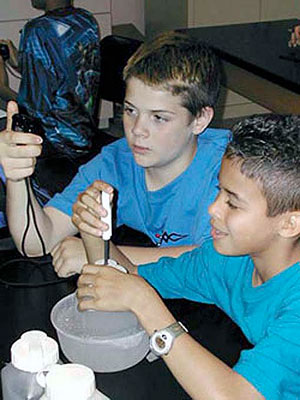
BEAMS students learn about energy transfer, insulators and scientific procedure during the "Cold Stuff" activity. Jefferson Lab volunteers are needed to help the students with a range of activities.
Becoming Enthusiastic About Math and Science – or BEAMS – Jefferson Lab's long-running math and science enrichment program for students needs your help. Lab staff members, users and students, interested in assisting with student activities conducted at the lab during normal business hours, are encouraged to contact Christine Wheeler, Science Education. BEAMS supports Newport News inner-city public school students as they progress from fifth through eighth grade. Nearly 1,500 students and their teachers visit JLab between two and five days each school year to participate in science and math activities conducted by scientists, engineers, technicians and administrators. Volunteers are also needed to provide 15-minute Role Model visits in their office or other appropriate work area for the students. "If you aren't available for a longer activity, Role Model visits are a great way to help out," Wheeler notes. For the 2012-2013 academic year, BEAMS class visits will begin in early October and will run through May 2013. Usually two classes attend at a time and participate in two to four separate activities during each day-long visit. "JLab staff, students and users are critical to the success of the lab's science education programs, especially BEAMS," Wheeler says. "Our BEAMS volunteers have been sharing their passion and excitement for math, science and technology with students for more than 20 years. Students get to learn about you and your job and you get to have fun working with lots of smiling faces. Everybody wins!" "From right here at the lab, you have a chance to make a difference in the lives of these students. We're always happy to welcome back volunteers who have helped in the past, and we are eager to welcome first-time volunteers," she adds. "Want to help, but not sure how? That's what we're here for," Wheeler explains. "Science Education staff will provide the training you need. Members of the education group are happy to go over any activity whether you are new to the program or if you'd like a refresher. If you want to observe a classroom activity to see if it's something you want to do, we can schedule that, too." For additional information, class visit schedules and activity opportunities, contact Wheeler at ext. 7560 or email wheelerc@jlab.org. The BEAMS program's goals include: motivating students to boost their learning; strengthening students' math and science skills with hands-on activities, and having them interact with individuals who use math and/or science in their daily work environment. BEAMS also provides teachers with classroom activities based on JLab science and technology. You may view several of the activities' work sheets at the following pdf links: Results In from Newsletter Readership SurveyWhen it comes to learning news about Jefferson Lab, staff and users rely on all-staff emails, their supervisors, the lab's website, co-workers, Insight and the OnTarget newsletter as their "most important" sources of information. That's just one of the results from a recent online survey of OnTarget readers. The survey also found that engineering and technology stories are the favorites among readers. Other popular story subjects are those about ongoing construction projects at the lab, nuclear physics research, the 12 GeV Upgrade and stories about employees. Nearly 90 percent of those who participated in the survey said that OnTarget "effectively communicates information about Jefferson Lab." Nearly half of those surveyed said they prefer to read the online version of the newsletter, rather than the pdf version. Survey participants also offered some criticisms and suggestions for improving the newsletter, such as requesting more human interest stories, incorporating multimedia into the newsletter and stories that discuss future plans at the lab. These suggestions and other results from the survey will be used to improve and shape future issues of OnTarget. Quark Cafe Staff Wins Regional Award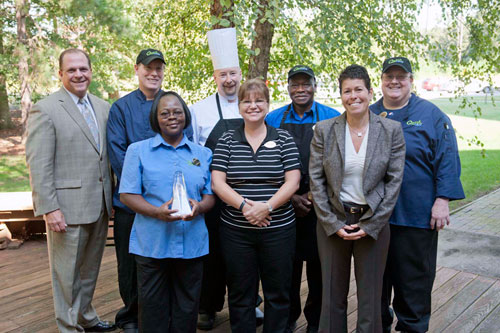
Quark Cafe staff members pause for a group photo after they were presented with Eurest's 2012 Mid-Atlantic Region Be A Star Award. Pictured are (back row, left to right) Mark Gleason, regional vice president; Craig Tegenborg; Adrian Durant, executive chef; Albert McClinton; and Patricia Barry, and (front, l.-r.) Sandra Graham; Gaye Davenport, food services director; and Mona Tagliaferro, regional director.
Quark Cafe staff members received a very pleasant surprise after winding up breakfast service on Sept. 12. They knew their Eurest regional director, Mona Tagliaferro, was stopping by for a visit and that she would be accompanied by the regional vice president, Mark Gleason, who was making his first visit to Jefferson Lab and Quark Cafe. But, only Gaye Davenport, the cafeteria's food services director, knew that the purpose of the visit was to present an award to the Quark Cafe staff. Accompanied by representatives of Jefferson Lab's leadership and Staff Services, Gleason and Tagliaferro presented the Quark Cafe/Eurest team with the 2012 Mid-Atlantic Region, Be A Star Award. The Eurest team that runs Quark Cafe and handles catering for Jefferson Lab is one of nearly 50 units in the Mid-Atlantic Region that was eligible for the award, according to Gleason. Eurest is the Charlotte, N.C.-based company that has the contract to provide food services at Jefferson Lab. In presenting the award trophy to Davenport, Gleason commended Davenport's leadership and her team's dedication, enthusiasm and teamwork. He also applauded the group's individual and professional emphasis on customer service. "I hear a lot about our units," Gleason said, "and what I hear about this team is exceptionally good. They really focus on customer service and going above and beyond expectations. It is embedded in the culture of each member of this team and how they perform as a group. They focus on customer service and client satisfaction every day." In addition to the trophy, each Quark Cafe team member received a monetary award. As Gleason presented the envelopes, he said to the team, "Thank you for what you do every day, for the client and to support each other." Tagliaferro added to the accolades. "I always appreciate the warm feeling I get when I walk in the door here," she commented, "and I appreciate it. Our team works as one with the client (the lab) and the customers. Food preparation, sanitation, service and caring: each one of you plays an important part in making it all happen." Speaking on behalf of Jefferson Lab, Mike Dallas, chief operating officer, said, "The Quark Cafe team does a great job every day. They prepare and serve great food. They smile and are sincere with everyone who visits the cafeteria. We have a lot of visitors come through here and many of them have commented on the great food and service they get here." "And, you make the best egg-white omelet with spinach and feta," he added, referring to his favorite breakfast – made nearly every day for him by Quark Cafe staff. Eurest's "Be A Star" program acknowledges and awards associates and groups who "go above and beyond" in their commitment to service excellence and for outstanding achievements, according to Gleason. Eurest's Quark Cafe team includes Davenport, Executive Chef Adrian Durant, Sandra Graham, Patricia Barry, Craig Tegenborg and Albert McClinton. Graphic Artist Wins Design Award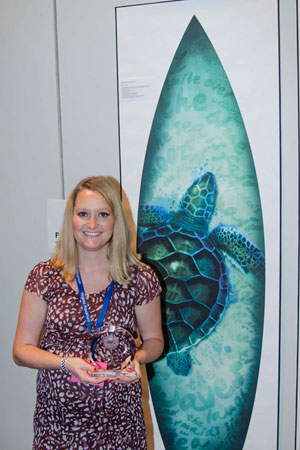
Joanna Griffin, graphic artist, earned a design award at the inaugural Show for Hampton Roads Excellence in Design event held at the Virginia Aquarium on Aug. 22.
Joanna Griffin, Jefferson Lab graphic artist, earned an award at the inaugural Show for Hampton Roads Excellence in Design, or SHRED 2012, held at the Virginia Aquarium on Aug. 22. Drawing inspiration from a poem titled "The Sea Spirit" by Lucy Maud Montgomery, Griffin created a surfboard design rich in fluid shades of green and blue-green that includes a sea turtle and is awash with words that form an excerpt of the poem. The competition, planned by the Professional Association for Design, also known as AIGA, and in conjunction with the East Coast Surfing Championships, invited local artists and graphic artists, professionals, amateurs and students, to create and submit surfboard and skateboard designs. All 76 entries were reviewed by a panel of judges, by surfers who attended the Coastal Edge ECSC Legends Gala on Aug. 22, and by the public via Facebook. Griffin's design took top honors in the Surfer's Choice category at the gala. "I was surprised," Griffin said after receiving the award, "there were so many great designs! I was very happy to receive this particular award, because it was the one chosen by the surfers." Griffin's efforts earned her an engraved glass trophy and gift bag. After the event, the designs were auctioned to raise money to support a program dubbed "Access Aquarium" at the Virginia Aquarium and Marine Science Center.
Milestones for July-August 2012Hello Goodbye These Milestone entries, listed alphabetically, are full-time, term, casual and student actions posted by Human Resources for July and August 2012. Jefferson Lab is currently seeking qualified individuals for a small number of technical and scientific positions. All current employment opportunities are posted at: [Link Removed] = Information about career opportunities at Jefferson Lab is available at: [Link Removed] ScrapbookInstallation of CHL2 Cold Boxes and Support Systems Continue A number of Linde Group and PHPK Technologies workers have been involved periodically over the last several months in the assembly and installation of components and systems necessary for the operation of Central Helium Liquefier II. The new refrigeration system, in conjunction with the existing CHL will provide the cryogenic refrigeration necessary for CEBAF to operate at 12 GeV, or 12 billion electron volts. The assembly and installation involves the two huge cold boxes, compressors and supporting equipment that have been delivered to the lab since last year. The Linde Group and PHPK Technologies returned to the lab in August to complete more assembly of the 300-60 Kelvin outside cold box and 60-4.5 K inside cold box. A cold box cools and purifies compressed helium for distribution and liquefaction, then warms the return flow to the compressors.
|
|||
|
The On Target newsletter is published monthly by the Thomas Jefferson National Accelerator Facility (Jefferson Lab), a nuclear physics research laboratory in Newport News, Virginia, operated by Jefferson Science Associates, LLC, for the U.S. Department of Energy's Office of Science. Possible news items and ideas for future stories may be emailed to jlabinfo@jlab.org, or sent to the Jefferson Lab Public Affairs Office, Suite 15, 12000 Jefferson Avenue, Newport News, VA 23606
|


 A day-long deluge on August 25 caused flash flooding at Jefferson Lab and marked the second time this year that the lab has experienced flash flooding from heavy rainstorms......
A day-long deluge on August 25 caused flash flooding at Jefferson Lab and marked the second time this year that the lab has experienced flash flooding from heavy rainstorms...... As a child growing up in northern Virginia, Cynthia Keppel loved to tinker. Her dad, an entrepreneur with wide-ranging interests,......
As a child growing up in northern Virginia, Cynthia Keppel loved to tinker. Her dad, an entrepreneur with wide-ranging interests,...... Many people choose a career early in life, fit their educational path to their career goal, and have a straight trajectory toward that goal.......
Many people choose a career early in life, fit their educational path to their career goal, and have a straight trajectory toward that goal.......